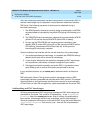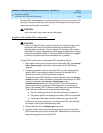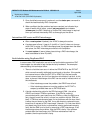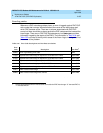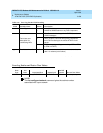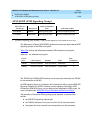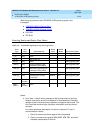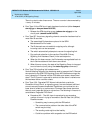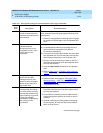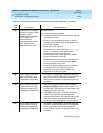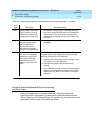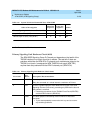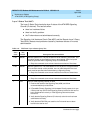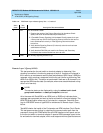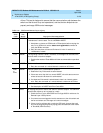
DEFINITY ECS Release 8.2 Maintenance for R8.2csi
555-233-119 Issue 1
April 2000
Maintenance Objects
3-212ATM-SGRP (ATM Signaling Group)
3
f. Error Type 1793: failure of the Layer 2 Query Test for the primary signaling
channel.
■ Excessive AAL - The AAL layer is experiencing an excessive
number of errors in trying to reconstruct Service Data Unit (SDUs).
Possible causes:
— Something may be wrong with the ATM switch.
— The communication paths on the other side of the ATM
switch may be noisy.
— The sending node might not be healthy. It could also be a
problem with congestion on the ATM switch.
g. Error Type 2305: the Remote Layer 3 Query Test (#637) failed. A specific
message was sent to the far-end switch, and it did not respond within the
allotted time.
1. Investigate elements of the ATM D-channel(s) (ATM-DCH) for both
this switch and the Far-end switch.
If Test #637 fails twice in a row, the B-channels are alarmed and made
unavailable for outgoing calls (although incoming calls are still accepted).
When Test #637 succeeds and the Far-end switch starts responding
properly, the ATM Trunk (B-channels) are placed back into normal
operation and their alarms retired.
h. Error Type 3585: A SERV or SERV ACK ISDN D-channel message has
been received by a non-US-type interface (country option other than
1
on
the DS1 administration form). However, these messages are used only for
duplex NFAS signaling, which is supported by country protocol 1.
Thus, there may be a mismatch in administration between the local and
far-end switches.
1. Consult with the customer’s network provider to determine whether
the D-channel is set up correctly on the far-end switch.
i. Error Type 3840-3928: These error types are used to report certain error
messages received by the ATM-SGRP Signaling Group for one of its
associated B-channels. The Aux Data field is the port number of the
B-channel from which the message was received.
The error code generated equals 3840+
x
, where
x
is a Cause Value
defined by the ISDN PRI Specification. Note that there is no Test to Clear
Value for these error types; selected ISDN cause values are placed in the
log when they are received, but no direct action or alarming is performed
solely in response to receiving them. They provide added data that may
prove useful when tracking down obscure networking and routing
problems. Table 3-88
provides more information about this range of Error
Codes:



